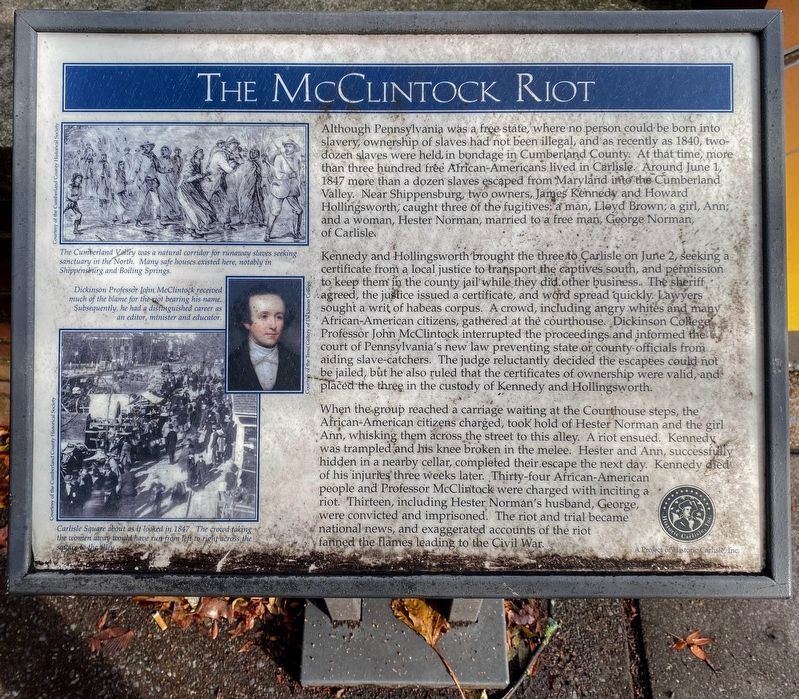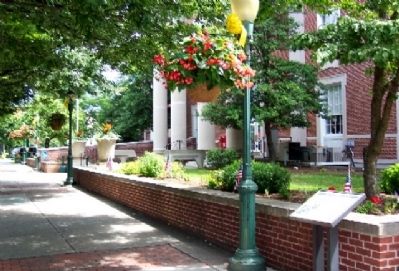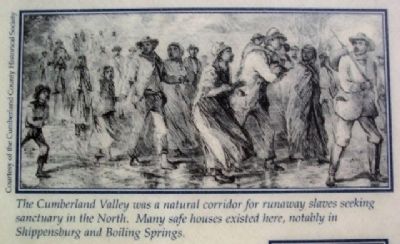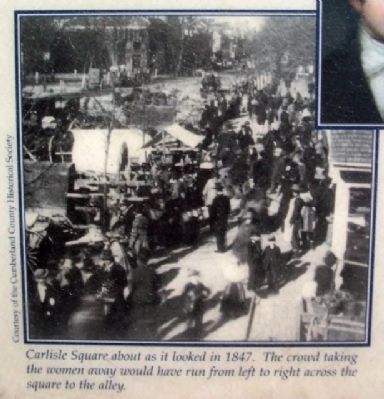Carlisle in Cumberland County, Pennsylvania — The American Northeast (Mid-Atlantic)
The McClintock Riot
Walking Tour Stop 8
Although Pennsylvania was a free state, where no person could be born into slavery, ownership of slaves had not been illegal, and as recently as 1840, two-dozen slaves were held in bondage in Cumberland County. At that time, more than three hundred free African-Americans lived in Carlisle. Around June 1, 1847 more than a dozen slaves escaped from Maryland into the Cumberland Valley. Near Shippensburg, two owners, James Kennedy and Howard Hollingsworth, caught three of the fugitives: a man, Lloyd Brown; a girl, Ann; and a woman, Hester Norman, married to a free man, George Norman, of Carlisle.
Kennedy and Hollingsworth brought the three to Carlisle on June 2, seeking a certificate from a local justice to transport the captives south, and permission to keep them in the county jail while they did other business. The sheriff agreed, the justice issued a certificate, and word spread quickly. Lawyers sought a writ of habeas corpus. A crowd, including angry whites and many African-American citizens, gathered at the courthouse. Dickinson College Professor John McClintock interrupted the proceedings and informed the court of Pennsylvania’s new law preventing state or county officials from aiding slave-catchers. The judge reluctantly decided the escapees could not be jailed, but he also ruled that the certificates of ownership were valid, and placed the three in the custody of Kennedy and Hollingsworth.
When the group reached a carriage waiting at the Courthouse steps, the African-American citizens charged, took hold of Hester Norman and the girl Ann, whisking them across the street to this alley. A riot ensued. Kennedy was trampled and his knee broken in the melee. Hester and Ann, successfully hidden in a nearby cellar, completed their escape the next day. Kennedy died of his injuries three weeks later. Thirty-four African-American people and Professor McClintock were charged with inciting a riot. Thirteen, including Hester Norman’s husband, George, were convicted and imprisoned. The riot and trial became national news, and exaggerated accounts of the riot fanned the flames leading to the Civil War.
Erected by Historic Carlisle, Inc.
Topics. This historical marker is listed in these topic lists: Abolition & Underground RR • African Americans. A significant historical month for this entry is June 1872.
Location. 40° 12.057′ N, 77° 11.341′ W. Marker is in Carlisle, Pennsylvania, in Cumberland County. Marker is at the intersection of Hanover Street (Pennsylvania Route 34) and Liberty Avenue, on the right when traveling north on Hanover Street. Marker is on the grounds of the current county courthouse, on the SE quadrant
of the Public Square. Touch for map. Marker is at or near this postal address: 1 Courthouse Square, Carlisle PA 17013, United States of America. Touch for directions.
Other nearby markers. At least 8 other markers are within walking distance of this marker. Old Town Pump (here, next to this marker); Market House Square (within shouting distance of this marker); Col. Robert Magaw (within shouting distance of this marker); Carlisle Court House (within shouting distance of this marker); Blaine House (within shouting distance of this marker); Historic Downtown Carlisle (within shouting distance of this marker); Green Tree Inn (within shouting distance of this marker); The Shelling of Carlisle (within shouting distance of this marker). Touch for a list and map of all markers in Carlisle.
Also see . . . Life and Letters of the Rev. John McClintock. (Submitted on May 18, 2010, by William Fischer, Jr. of Scranton, Pennsylvania.)
Credits. This page was last revised on January 12, 2022. It was originally submitted on May 18, 2010, by William Fischer, Jr. of Scranton, Pennsylvania. This page has been viewed 1,763 times since then and 113 times this year. Photos: 1. submitted on December 19, 2021, by Shane Oliver of Richmond, Virginia. 2, 3, 4. submitted on May 18, 2010, by William Fischer, Jr. of Scranton, Pennsylvania.



